小学英语介词at、in、on
介词atin与on的用法与区别
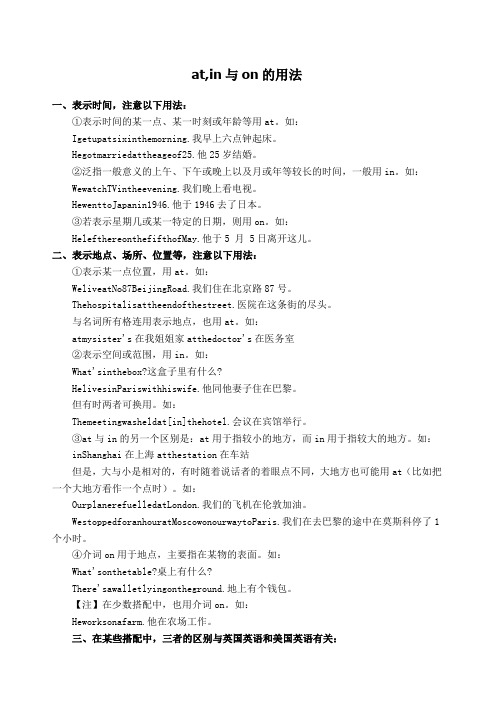
at,in与on的用法一、表示时间,注意以下用法:①表示时间的某一点、某一时刻或年龄等用at。
如:Igetupatsixinthemorning.我早上六点钟起床。
Hegotmarriedattheageof25.他25岁结婚。
②泛指一般意义的上午、下午或晚上以及月或年等较长的时间,一般用in。
如:WewatchTVintheevening.我们晚上看电视。
HewenttoJapanin1946.他于1946去了日本。
③若表示星期几或某一特定的日期,则用on。
如:HelefthereonthefifthofMay.他于5 月 5日离开这儿。
二、表示地点、场所、位置等,注意以下用法:①表示某一点位置,用at。
如:WeliveatNo87BeijingRoad.我们住在北京路87号。
Thehospitalisattheendofthestreet.医院在这条街的尽头。
与名词所有格连用表示地点,也用at。
如:atmysister's在我姐姐家atthedoctor's在医务室②表示空间或范围,用in。
如:What'sinthebox?这盒子里有什么?HelivesinPariswithhiswife.他同他妻子住在巴黎。
但有时两者可换用。
如:Themeetingwasheldat[in]thehotel.会议在宾馆举行。
③at与in的另一个区别是:at用于指较小的地方,而in用于指较大的地方。
如:inShanghai在上海atthestation在车站但是,大与小是相对的,有时随着说话者的着眼点不同,大地方也可能用at(比如把一个大地方看作一个点时)。
如:OurplanerefuelledatLondon.我们的飞机在伦敦加油。
WestoppedforanhouratMoscowonourwaytoParis.我们在去巴黎的途中在莫斯科停了1个小时。
④介词on用于地点,主要指在某物的表面。
小学英语介词的用法总结

介词的用法1 .表示地点位置的介词1)at ,in, on, to, forat⑴表示在小地方;(2)表示“在……附近,旁边”in⑴表示在大地方;(2)表示“在.一范围之内”。
on表示毗邻,接壤,“在……上面”。
to表示在……范围外,不强调是否接壤;或“到……”2)above, over, on 在……上above指在……上方,不强调是否垂直,与below相对;over指垂直的上方,与under相对,但over与物体有一定的空间,不直接接触。
on表示某物体上面并与之接触。
The bird is flying above my head. There is a bridge over the river.He put his watch on the desk.3)below, under 在... 下面under表示在…正下方below表示在……下,不一定在正下方There is a cat under the table.Please write your name below the line.4)in front [frant]of, in the front of 在..... 前面in front of…意思是“在……前面”,指甲物在乙物之前,两者互不包括;其反义词是behind (在.. 的后面)。
There are some flowers in front of the house.(房子前面有些花卉。
)in the front of意思是"在…..的前部”,即甲物在乙物的内部.反义词是at the back of…(在……范围内的后部)。
There is a blackboard in the front of our classroom.我们的教室前边有一块黑板。
Our teacher stands in the front of the classroom.我们的老师站在教室前.(老师在教室里)5)beside,behindbeside表示在... 旁边behind表示在... 后面2 .表示时间的介词1)in , on,at 在... 时in表示较长时间,如世纪、朝代、时代、年、季节、月及一般(非特指)的早、中、晚等。
介词in,at,on的用法 (2)
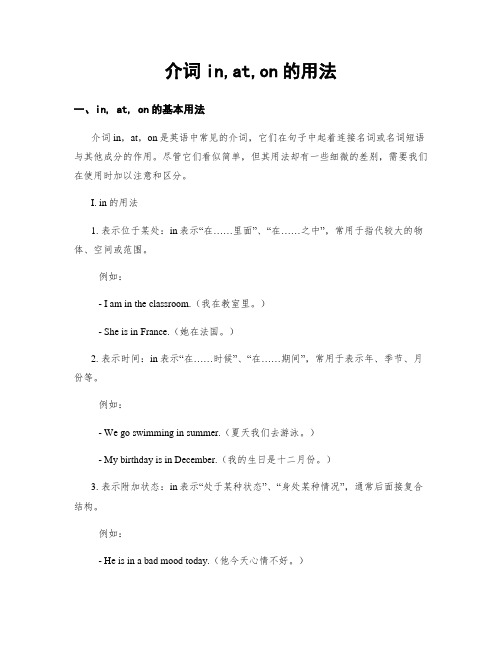
介词in,at,on的用法一、in, at, on的基本用法介词in,at,on是英语中常见的介词,它们在句子中起着连接名词或名词短语与其他成分的作用。
尽管它们看似简单,但其用法却有一些细微的差别,需要我们在使用时加以注意和区分。
I. in的用法1. 表示位于某处:in表示“在……里面”、“在……之中”,常用于指代较大的物体、空间或范围。
例如:- I am in the classroom.(我在教室里。
)- She is in France.(她在法国。
)2. 表示时间:in表示“在……时候”、“在……期间”,常用于表示年、季节、月份等。
例如:- We go swimming in summer.(夏天我们去游泳。
)- My birthday is in December.(我的生日是十二月份。
)3. 表示附加状态:in表示“处于某种状态”、“身处某种情况”,通常后面接复合结构。
例如:- He is in a bad mood today.(他今天心情不好。
)- The company is in financial trouble.(公司陷入了财务困境。
)II. at的用法1. 表示位置:at表示“在……地方”、“在某处”,常用于指代较小范围的地点、位置或具体场所。
例如:- She is waiting for you at the bus stop.(她在公交车站等你。
)- I will meet you at the cinema.(我会在电影院见你。
)2. 表示时间:at表示“在……具体时间点”,通常用于某一具体时刻、钟点或时间段。
例如:- The meeting starts at 9 a.m.(会议在上午九点开始。
)- I usually have dinner at 6:30 p.m.(我通常六点半吃晚饭。
)3. 表示动作进行的状态:at表示“正在进行某个动作”、“忙着做某事”,通常用于表示举止、动作进行中。
介词in,on,at用法与区别
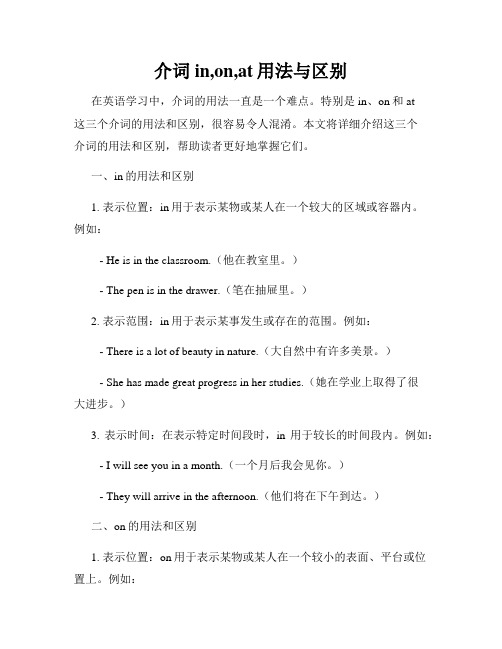
介词in,on,at用法与区别在英语学习中,介词的用法一直是一个难点。
特别是in、on和at这三个介词的用法和区别,很容易令人混淆。
本文将详细介绍这三个介词的用法和区别,帮助读者更好地掌握它们。
一、in的用法和区别1. 表示位置:in用于表示某物或某人在一个较大的区域或容器内。
例如:- He is in the classroom.(他在教室里。
)- The pen is in the drawer.(笔在抽屉里。
)2. 表示范围:in用于表示某事发生或存在的范围。
例如:- There is a lot of beauty in nature.(大自然中有许多美景。
)- She has made great progress in her studies.(她在学业上取得了很大进步。
)3. 表示时间:在表示特定时间段时,in用于较长的时间段内。
例如:- I will see you in a month.(一个月后我会见你。
)- They will arrive in the afternoon.(他们将在下午到达。
)二、on的用法和区别1. 表示位置:on用于表示某物或某人在一个较小的表面、平台或位置上。
例如:- The book is on the table.(书在桌子上。
)- He is sitting on the chair.(他正坐在椅子上。
)2. 表示日期和天:on用于具体的日期或星期几,以及天。
例如:- My birthday is on May 10th.(我的生日是在5月10日。
)- We have a meeting on Monday.(我们星期一开会。
)- I usually go jogging on sunny days.(我通常在晴天慢跑。
)3. 表示通讯媒介:on用于表示使用某种通讯媒介。
例如:- I heard the news on the radio.(我通过收音机听到了这个消息。
小学英语常用介词用法

小学英语常用介词用法在学习英语的过程中,掌握介词的正确用法是非常重要的。
介词是连接词与词之间关系的一种词类,它能够表示时间、地点、方式、原因等等。
在小学英语中,常用的介词有很多,下面将为大家介绍一些常用的介词及其用法。
1. in介词"in"用于表示在某个范围内或在某个具体的位置上。
例如:- I live in a house.- There is a book in the bag.2. on介词"on"用于表示在某个表面上。
例如:- The cup is on the table.- The picture is on the wall.3. at介词"at"用于表示在某个点、位置或地方。
例如:- He is waiting at the bus stop.- We will meet at the park.4. by介词"by"用于表示通过某种方式或手段。
例如:- I go to school by bus.- They communicate by email.5. for介词"for"用于表示目的、原因或表示给予的对象。
例如:- This gift is for you.- I study hard for good grades.6. with介词"with"用于表示陪伴或伴随的状态。
例如:- She went to the park with her friends.- He plays basketball with his brother.7. to介词"to"用于表示目的、方向、接触等。
例如:- I go to school every day.- She gives a present to her teacher.8. from介词"from"用于表示出发地、来源或起点。
小学英语介词用法
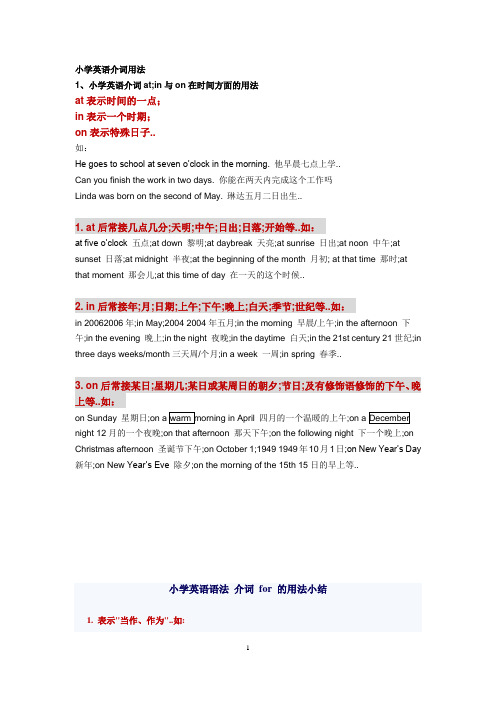
小学英语介词用法1、小学英语介词at;in与on在时间方面的用法at表示时间的一点;in表示一个时期;on表示特殊日子..如:He goes to school at seven o’clock in the morning. 他早晨七点上学..Can you finish the work in two days. 你能在两天内完成这个工作吗Linda was born on the second of May. 琳达五月二日出生..1. at后常接几点几分;天明;中午;日出;日落;开始等..如:at five o’clock 五点;at down 黎明;at daybreak 天亮;at sunrise 日出;at noon 中午;at sunset 日落;at midnight 半夜;at the beginning of the month 月初; at that time 那时;at that moment 那会儿;at this time of day 在一天的这个时候..2. in后常接年;月;日期;上午;下午;晚上;白天;季节;世纪等..如:in 20062006年;in May;2004 2004年五月;in the morning 早晨/上午;in the afternoon 下午;in the evening 晚上;in the night 夜晚;in the daytime 白天;in the 21st century 21世纪;in three days weeks/month三天周/个月;in a week 一周;in spring 春季..3. on后常接某日;星期几;某日或某周日的朝夕;节日;及有修饰语修饰的下午、晚上等..如:on Sunday 星期日;on a warm morning in April 四月的一个温暖的上午;on a December night 12月的一个夜晚;on that afternoon 那天下午;on the following night 下一个晚上;on Christmas afternoon 圣诞节下午;on October 1;1949 1949年10月1日;on New Year’s Day 新年;on Ne w Year’s Eve 除夕;on the morning of the 15th 15日的早上等..小学英语语法介词for 的用法小结1. 表示"当作、作为"..如:I like some bread and milk for breakfast. 我喜欢把面包和牛奶作为早餐..What will we have for supper 我们晚餐吃什么2. 表示理由或原因;意为"因为、由于"..如:Thank you for helping me with my English. 谢谢你帮我学习英语..Thank you for your last letter. 谢谢你上次的来信..Thank you for teaching us so well. 感谢你如此尽心地教我们..3. 表示动作的对象或接受者;意为"给……"、"对…… 而言"..如:Let me pick it up for you. 让我为你捡起来..Watching TV too much is bad for your health. 看电视太多有害于你的健康..4. 表示时间、距离;意为"计、达"..如:I usually do the running for an hour in the morning. 我早晨通常跑步一小时.. We will stay there for two days. 我们将在那里逗留两天..5. 表示去向、目的;意为"向、往、取、买"等..如:Let's go for a walk. 我们出去散步吧..I came here for my schoolbag.我来这儿取书包..I paid twenty yuan for the dictionary. 我花了20元买这本词典..6. 表示所属关系或用途;意为"为、适于……的"..如:It's time for school. 到上学的时间了..Here is a letter for you. 这儿有你的一封信..7. 表示"支持、赞成"..如:Are you for this plan or against it 你是支持还是反对这个计划8. 用于一些固定搭配中..如:Who are you waiting for你在等谁For example;Mr Green is a kind teacher. 比如;格林先生是一位心地善良的老师..小升初介词语法讲解地点介词in; at; on above; below; over; under; among; between的用法及区别1in; at与on的用法及区别①in表示地点;意为“在…内”;用于内部..如:There isn’t a cloud in the sky. 天空中没有一片云..He put his hands in his pockets. 他把手放入口袋..What’s in the box 盒子里有什么②on意为“在…上面”;用于表面接触;指在一个平面上..如:What’s on the table 桌子上有什么There was a carpet on the floor. 地板上铺着一块地毯..③表示“在某地”时;at后面接小地方;in后接大地方..如:at home在家 at the bus stop在汽车站 in China在中国 in the world 在世界上2above与below的用法及区别above的意思是“在…之上”“高于…”;表示相对高度;不一定是在正上方;它的反义词是below..如:The plane flew above the clouds. 飞机在云层上面飞行..The Dead Sea is below sea level. 死海的海面低于海平面..3over与under的用法及区别over的意思是“在…之上”;表示垂直之上;其反义词是under..如:There is a bridge over the river. 河上有座桥..There is a boat under the bridge. 桥下有只船..4among与between的用法及区别between一般指“两者之间”..among用于三个或三个以上的人或物之间;或笼统的一群人或一些物之中..如:The house stands between two farms. 这座房子位于两个农场之间..The house stands among farms. 这座房子位于农场之间..5beside与near的用法及区别本部分只出现在教师版中①beside表示“近旁”“紧靠”;相当于next to..如:Come and sit beside me. 来坐在我的身旁..②near意为“在…附近”;可以表示空间、时间关系等..如:He sits near the window. 他坐在窗户附近..6in front of与in the front of的用法及区别本部分只出现在教师版中in front of表示“在…之前”..表示在某一空间外部的前面;in the front of 表示在某一空间内部的前面..如:There are some trees in front of the classroom. 教室前有一些树..Don’t sit in the front of the car. 不要坐在小汽车的前部..3方式介词like像… with用… in用… by用…方式介词:with; by; in的用法及区别with; by; in表示工具、手段和材料时;with多指用工具;用身体的某一部位或器官;by表示使用的方法、手段;in指使用某种语言、工具的具体类型等..如:You can see it with your own eyes. 你可以亲自去看看..Why don’t we go there by car instead 我们为什么不坐小汽车去呢She can speak it in English. 她能用英语说..4其他含义的介词of具有…的性质 with带有… without没有… instead of而不是… except 除了…beside包括…在内1.表示地点位置的介词in; on; to;forat 1表示在小地方; 2表示“在……附近;旁边”in 1表示在大地方; 2表示“在…范围之内”..on 表示在……上面”..to 表示或“到……”under 在……下面in the front of在……前面behind在……的后面..There are some flowers in front of the house.房子前面有些花卉..beside 表示在……旁边behind 表示在……后面2.表示时间的介词1in ; on;at 在……时in表示较长时间;如世纪、朝代、时代、年、季节、月及一般非特指的早、中、晚等..如in the 20th century; in the 1950s; in 1989; in summer; in January; in the morning; in one’s life ; in one’s thirties等..on表示具体某一天及其早、中、晚..如on May 1st; on Monday; on New Year’s Day; on a cold night in January; on a fine morning; on Sunday afternoon等..at表示某一时刻或较短暂的时间;或泛指圣诞节;复活节等..如at 3:20; at this time of year; at the beginning of; at the end of …; at the age of …; at Christmas; at night; at noon; at this moment等..注意:在last; next; this; that; some; every 等词之前一律不用介词..如:We meet every day.2from 自从……3after; behind 在……之后after主要用于表示时间;behind主要用于表示位置..时间名词前介词用法口诀年前周前要用in具体日子却要禁遇到几号要用on上午下午又是in要说某日上下午用on换in记清楚午夜黄昏用at黎明用它也不错at用在时分前说“差”可要用上to说"过''要用past.表示“在……之间”的介词: between.about 关于2by; with; in 表示方法、手段、工具by 以……方法、手段或泛指某种交通工具;with 表示用…工具、手段;一般接具体的工具和手段;in 表示用…方式;用…语言语调、笔墨、颜色等;小学英语介词总结介词Preposition一、概述介词是英语中很活跃的词;一般置于名词之前..它常和名词或名词性词语构成介词短语..同一个介词常和不同的词语搭配形成固定搭配;表示不同意义..二、常用介词的基本用法at①表示时间:I go to school at seven every day 我每天早上7点去上学..②表示在某一具体地点:He is standing at the bus stop 他站在公共汽车站..③表示动作的方向、目标:Let me have a look at the picture 让我看看这幅图..④用于某些固定搭配:at once 立刻、马上at last 最后at the same time 同时at first 开始时not at all 一点也不about①表示大约时间:I's about six o'clock now. 现在大约6点钟了..②表示地点;在……周围:Everthing about me is so beautiful 我周围的一切都那么美好..③关于;对于:We are talking about the news. 我们正在谈论新闻..after①在……之后:After dinner I watch TV. 晚饭后我看电视..②在……后面:He came into the room after me. 他在我后面进了房间..behind①在……之后:There is a bike behind the tree. 树后有一辆自行车②比……晚;迟于:The train is behind time. 火车晚点了by①在……旁:He is sitting by the bed. 他正坐在床边..②到……时候:We have learned three English songs by now. 到现在为止;我们已经学会了三首英文歌曲..③以……方式:I go to school by bus. 我乘公共汽车去上学..④用于某些固定搭配:one by one 一个接一个by the way 顺便说一句for①为;给;替:I'll make a card for my teacher. 我要给老师做张卡片..②由于:Thank you for helping me. 谢谢你帮我..③表示给某人用的:There is letter for you. 这儿有你一封信..in①在……里面:The pencil is in the desk. 铅笔在课桌里..②在一段时间里:We have four classes in the morning. 我们上午有四节课..③用;以:What's this in English 这用英语怎么说④在某一年份;季节;月份:in 2002; in spring; in January⑤表示状态;服饰:Helen is in yellow. 海伦身穿黄色衣服..⑥在……方面:He is weak in English. 他的英语不行..⑦用于某些固定搭配:in front of 在……前面in the end 最后in time 及时like①像……样:He looks like his father. 他像他的父亲..②这样;那样:Don't look at me like that. 别那样看着我..③怎样:What's the weather like 天气怎样..near靠近;在……附近:My bed is near the window. 我的床在窗户旁..of①的表示所属关系:This is a photo of my family. 这是一张我家的照片..②……的用于所有格:He is a friend of mine. 他是我的一个朋友..③表示数量与连词连用:One of us is from Beijing. 我们中有一个来自北京④想到;谈到:I often think of them. 我常常想到他们..⑤用于某些固定搭配:of course 当然because of 因为;由于on①在……上面:There are some apple on the tree. 树上有些苹果..②在星期天;在某天的上午下午;晚上:They go to English class on Sunday. 星期天他们去上英语课..I left Beijing on the morning of May 1. 我在5月1日早上离开北京..③用于某些固定搭配:on duty 值日on time 准时over①在……正上方:There is a lamp over the table. 桌子上方有一盏灯..②遍及;穿过:There is a bridge over the river. 有座桥横跨那条河..③超过;不止:She is a little over 2. 她两岁多了..to①到;往;向:He walks to the window. 他走向窗户..②表示时间、数量;到……为止Please count from ten to thirty. 请从10数到30.③向;对;给:Happy New Year to you all. 大家新年好..underWhat's under your desk 你书桌底下是什么with①和;写:Could you go home with me 你能和我一起回家吗②表示伴随状态;带有:Who's that girl with glasses 那位戴眼睛的女孩是谁三、介词的固定搭配1介词和名词的连用2动词和介词的连用at arrive at/in 到达at first 起初;开始get off 下车at last 最后help sb. With sth. 帮组某人做某事at school 在上课;在上学ask for 请求at the moment 此刻get up 起床at home 在家;无拘束laugh at 嘲笑at present 现在learn from 向……学习at work 上班;在工作look after 照顾at the same time 同时look for 寻找think for 想到on worry about 担心on duty 值日listen to 听on holiday 度假look at 看;注视on time 准时talk about 交谈;谈on the left/right 在左/右边wait for 等候;等on the radio 在广播中thank for 为……而感谢on foot 步行on sale 出售;降价出售3形容词和介词连用on TV 在电视上播放be afraid of 害怕on the phone 在电话中be careful with 小心;关心on the way 在路上be interested in 对……感兴趣be good at 善于in be proud of 感到自豪in all 总体be crazy about 酷爱in class 在课堂上be late for 干某事迟到in English 用英语be good for 对……有利in short 总之4其他in a hurry 匆忙地by+交通工具in the end 最后by bus/train/plane/air/ship/bike/sea/land…in bed 躺在床上lots of/a lot of 许多;大量in danger 在危险中at most 至多in fact 事实上at least 至少in time 及时地at once 立刻;马上in a minute 立刻 in order to 为了介词in at from about on by to for of with的用法⑴时间或地点介词in、on、at的用法区别:表示时间时; in表示在一段时间里在将来时句子中则表示在一段时间之后; on表示在具体的某一天或者某天的上下午等; at表示在某个时刻或者瞬间;表示地点时; in表示在某个范围之内; on表示在某个平面上或与一个面相接触;at则表示在某个具体的场所或地点..如:He was born on the morning of May 10th.他出生于五月十日的早晨/ I usually get up at 7:00 in the morning.我通常在早上的七点钟起床/ His glasses are right on his nose.他的眼镜就架在他的鼻子上/ He is at the cinema at the moment.此刻他正在电影院⑵after与in表示时间的用法区别:“after+具体时刻/从句”表示“在…时刻之后”常用于一般时态;“in+一段时间”表示“在多久之后”;常用于将来时态..如:He said that he would be here after 6:00.他说他六点钟之后会来这儿/ My father is coming back from England in about a month.我父亲大约一个月以后从英国回来⑶since与for表示时间的用法区别:“since+具体时刻/that-从句”表示“自从…起一直到现在”;“for +一段斶间”表示“总共有…之久”;都常用于完成时态;如:Uncle Li has worked in this factory since 1970.李叔叔自从1970年起就在这家工厂工作了/ Uncle Li has worked in this factory for over 30 years. 李叔叔在这家工厂已经工作了30多年⑷by、in与with表示方式的用法区别:都可以表示“工具、手段”;但是by主要表示“乘坐”某个交通工具或“以……方式”;在被动句中可以表示动作的执行者;in表示“使用”某种语言/文字;with表示“使用”某个具体的工具、手段..如:We see with our eyes and walk with our feet.我们用眼睛看东西;用双脚走路/ Please write that article文章in English.请你用英语写那篇文章/ Let’s go to the zoo by taxi.我们打的去动物园吧../ It was written by Lao She.那是老舍写的⑸about与on的用法区别:都可以表示“有关…”;但是about的意义比较广;而on主要表示“有关…专题/课程”..如:Tom is going to give a talk on the history of America.汤姆要作一个美国历史的报告/ They are very excited talking about the coming field trip.他们兴致勃勃地谈论着即将来到的野外旅游⑹through与across、over的用法区别:through指“穿过…门洞/人群/树林”;across 和over可以指“跨越…街道/河流”;可互换;但是表示“翻过…”时只能用over. 如:Just then a rat 鼠ran across the road.就在那时一只老鼠跑过路面/ There is a bridgeacross/over the river.河上有座桥/ They climbed over the mountain and arrived there ahead of time.他们翻过大山提前到达了那里/ The visitors went through a big gate into another park.参观者们穿过一个大门来到另一个公园7as与like的区别:两个词都表示“像……”;但是as译为“作为……”;表示的是职业、职务、作用等事实;而like译为“像……一样”;表示外表;不是事实..如:Let me speak to you as a father.我以父亲的身份和你讲话..说话者是听者的父亲/ Let me speak to you like a father.让我像一位父亲一样和你讲话说话者不是听者的父亲8at the end of、by the end of、to the end、in the end的用法区别:at the end of…既可以表示时间也可以表示地点;译为“在…末;在…尽头”;常与过去时连用;by the end of…只能表示时间;译为“在…前;到…为止”;常用于过去完成时;in the end与at last基本等义;表示“终于、最后”;通常用于过去时;to the end译为“到…的终点为止”;前面往往有表示运动或连续性的动词..如:By the end of last term we had learned 16 units of Book III.到上学期期末我们已经学习了第三册16个单元/ At the end of the road you can find a big white house with brown windows.在路的尽头你能找到一幢有棕色窗户的白房子/ They left for Beijing at the end of last week.上周末他们动身去了北京/ In the end he succeeded in the final exams.他最终在期末考试中考及格了/ We should go on with the work to the end.我们应该把工作干到底/ Follow this road to the end and you will see a post office.沿这条路走到底就能看见一家邮电局9for a moment、for the moment、in a moment、at the moment的区别:for a moment“一会儿、片刻”=for a while;常与持续性动词连用;for the moment“暂时、目前”;常用于现在时;in a moment“一会儿、立即、马上”=soon; in a few minutes;一般用于将来时;at the moment“此刻;眼下”=now;用于现在进行时..如:Please wait for a moment.请稍等/ Let’s leave things as they are for the moment.暂时就维持现状吧/ I’ll come back in a moment.我过会儿回来/ I am very busy at the moment.眼下我很忙10but的问题:用介词but引出另一个动词时;要注意:如果前面有do;后面就用原形动词;前面没有do时;后面的动词要加to..如:I could do nothing but wait.我什么也做不了只能等/ They had no choice选择but to fight.他们没有选择只有战斗11in front of 与in the front of:in front of“在…的前面”; 与in the front of“在…的前部”..如:A car was parking in front of the hall.大厅跟前停着一辆汽车/ In the front of the hall stood a big desk.大厅前部立着一个大讲台12except for与besides的区别:except“除了”;表示排除掉某人物;即不包含;而besides“除了”则表示包含;即“不仅……又……”..如:Everyone went to the Palace Museum except Tom.除了Tom;大家都去了故宫博物院Tom没有去故宫/ Besides Chinese he also studied many other subjects.除了汉语之外;他还学其他许多功课“汉语”也是他学的功课之一other than 除了......之外...... There 're nobody here other than me 与.....不同..... 与.....不同方式.....we can't get there other than by swimming.Apart from : with the exception of ...; besides... Apart form a few scratches; the car was undamaged1.They talk _______ a long time.What are they talking__________2.Playing computers games too long is really bad ______your eyes.3.Don't stand too near __________ the tiger cage;it's dangerous.4.The moon looks ___________ a plate in the sky.5.We should try to do everything ___________ ourselves.。
in,on,at的用法和区别
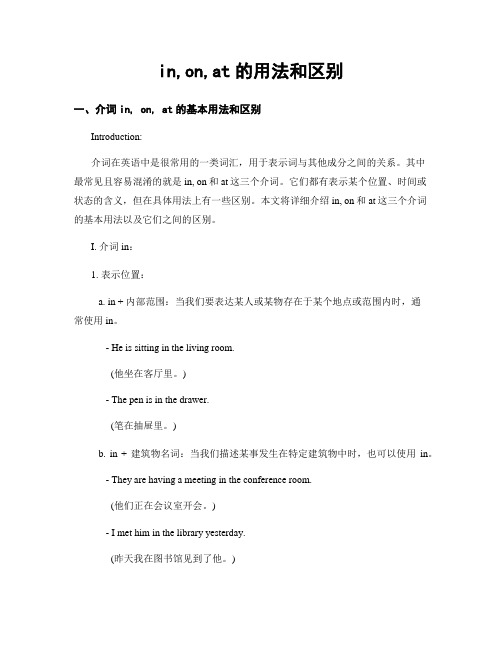
in,on,at的用法和区别一、介词in, on, at的基本用法和区别Introduction:介词在英语中是很常用的一类词汇,用于表示词与其他成分之间的关系。
其中最常见且容易混淆的就是in, on和at这三个介词。
它们都有表示某个位置、时间或状态的含义,但在具体用法上有一些区别。
本文将详细介绍in, on和at这三个介词的基本用法以及它们之间的区别。
I. 介词in:1. 表示位置:a. in + 内部范围:当我们要表达某人或某物存在于某个地点或范围内时,通常使用in。
- He is sitting in the living room.(他坐在客厅里。
)- The pen is in the drawer.(笔在抽屉里。
)b. in + 建筑物名词:当我们描述某事发生在特定建筑物中时,也可以使用in。
- They are having a meeting in the conference room.(他们正在会议室开会。
)- I met him in the library yesterday.(昨天我在图书馆见到了他。
)2. 表示时间:a. in + 年份/季节/月份/早上、下午等概括性时间段:使用in来表示较为宽泛的时间范围。
- She was born in 1990.(她出生于1990年。
)- I love to go swimming in summer.(我喜欢在夏天去游泳。
)b. in + 具体日期:当我们要指定一个具体的日期时,同样使用in。
- We have an appointment in two weeks.(我们有个在两周后的约会。
)- The seminar will be held in October.(研讨会将在10月份举行。
)3. 表示状态:a. 表示事物所处的状态或情况。
- She is in a good mood today.(她今天心情很好。
)- The project is currently in development.(项目目前还在开发中。
介词on、in、at-的用法.
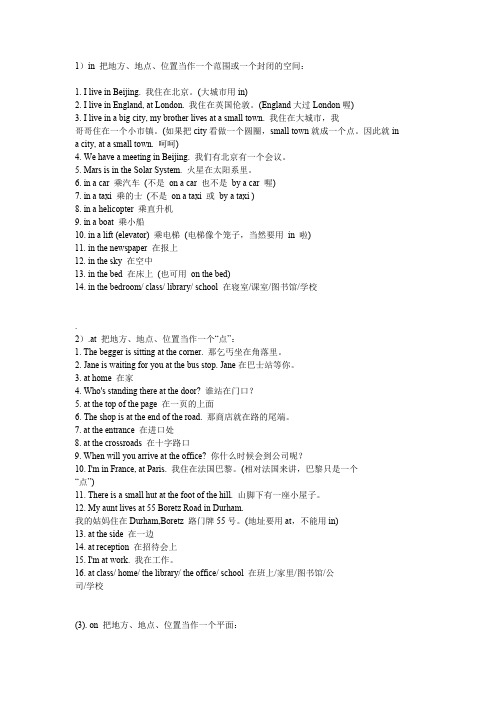
1)in 把地方、地点、位置当作一个范围或一个封闭的空间:1.I live in Beijing. 我住在北京。
(大城市用in)2.I live in England, at London. 我住在英国伦敦。
(England大过London喔)3.I live in a big city, my brother lives at a small town. 我住在大城市,我哥哥住在一个小市镇。
(如果把city看做一个圆圈,small town就成一个点。
因此就ina city, at a small town. 呵呵)4.We have a meeting in Beijing. 我们有北京有一个会议。
5.Mars is in the Solar System. 火星在太阳系里。
6.in a car 乘汽车(不是on a car 也不是by a car 喔)7.in a taxi 乘的士(不是on a taxi 或by a taxi )8.in a helicopter 乘直升机9.in a boat 乘小船10.in a lift (elevator) 乘电梯(电梯像个笼子,当然要用in 啦)11.in the newspaper 在报上12.in the sky 在空中13.in the bed 在床上(也可用on the bed)14.in the bedroom/ class/ library/ school 在寝室/课室/图书馆/学校.2).at 把地方、地点、位置当作一个“点”:1.The begger is sitting at the corner. 那乞丐坐在角落里。
2.Jane is waiting for you at the bus stop. Jane在巴士站等你。
3.at home 在家4.Who's standing there at the door? 谁站在门口?5.at the top of the page 在一页的上面6.The shop is at the end of the road. 那商店就在路的尾端。
介词in_on_at用法与区别
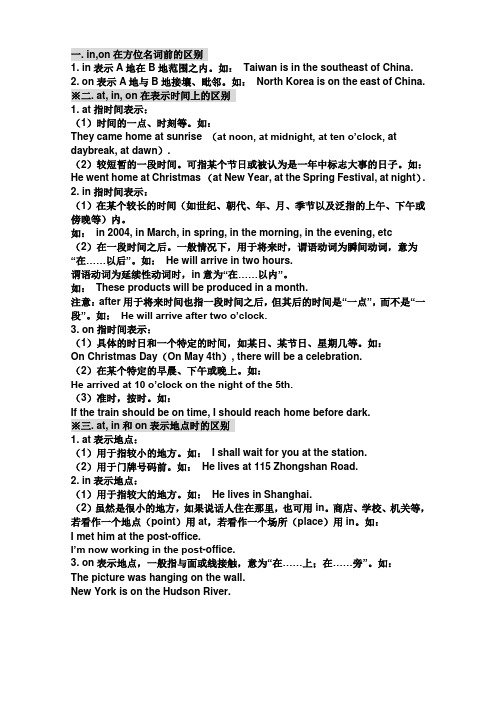
一. in,on在方位名词前的区别1. in表示A地在B地范围之内。
如:Taiwan is in the southeast of China.2. on表示A地与B地接壤、毗邻。
如:North Korea is on the east of China. ※二. at, in, on在表示时间上的区别1. at指时间表示:(1)时间的一点、时刻等。
如:They came home at sunrise (at noon, at midnight, at ten o’clock, at daybreak, at dawn).(2)较短暂的一段时间。
可指某个节日或被认为是一年中标志大事的日子。
如:He went home at Christmas (at New Year, at the Spring Festival, at night).2. in指时间表示:(1)在某个较长的时间(如世纪、朝代、年、月、季节以及泛指的上午、下午或傍晚等)内。
如:in 2004, in March, in spring, in the morning, in the evening, etc(2)在一段时间之后。
一般情况下,用于将来时,谓语动词为瞬间动词,意为“在……以后”。
如:He will arrive in two hours.谓语动词为延续性动词时,in意为“在……以内”。
如:These products will be produced in a month.注意:after用于将来时间也指一段时间之后,但其后的时间是“一点”,而不是“一段”。
如:He will arrive after two o’clock.3. on指时间表示:(1)具体的时日和一个特定的时间,如某日、某节日、星期几等。
如:On Christmas Day(On May 4th), there will be a celebration.(2)在某个特定的早晨、下午或晚上。
介词at和on和in区别
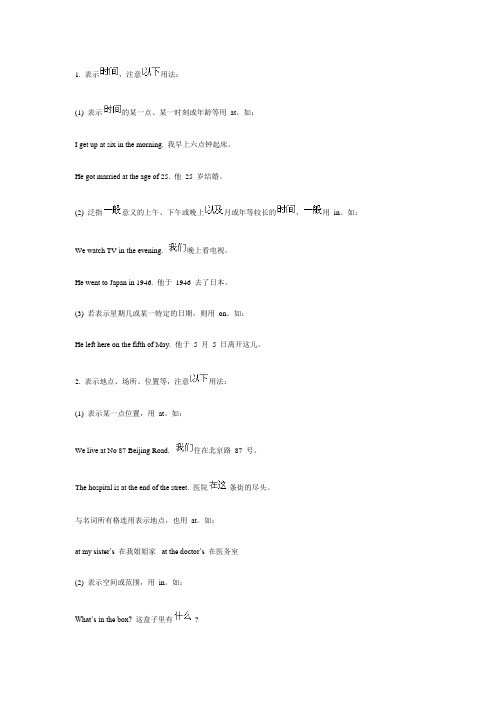
1. 表示,注意用法:(1) 表示的某一点、某一时刻或年龄等用at。
如:I get up at six in the morning. 我早上六点钟起床。
He got married at the age of 25. 他25 岁结婚。
(2) 泛指意义的上午、下午或晚上月或年等较长的,用in。
如:We watch TV in the evening. 晚上看电视。
He went to Japan in 1946. 他于1946 去了日本。
(3) 若表示星期几或某一特定的日期,则用on。
如:He left here on the fifth of May. 他于5 月5 日离开这儿。
2. 表示地点、场所、位置等,注意用法:(1) 表示某一点位置,用at。
如:We live at No 87 Beijing Road. 住在北京路87 号。
The hospital is at the end of the street. 医院条街的尽头。
与名词所有格连用表示地点,也用at。
如:at my sister’s 在我姐姐家at the doctor’s 在医务室(2) 表示空间或范围,用in。
如:What’s in the box? 这盒子里有?He lives in Paris with his wife. 他同他妻子住在巴黎。
但有时两者可换用。
如:The meeting was held at [in] the hotel. 会议在宾馆举行。
(3) at 与in 的另区别是:at 用于指较小的地方,而in 用于指的地方。
如:in Shanghai 在上海at the station 在车站,大与小是的,有时说话者的着眼点不同,大地方也用at(比如把大地方看作点时)。
如:Our plane refuelled at London. 的飞机在伦敦加油。
We stopped for an hour at Moscow on our way to Paris. 在去巴黎的途中在莫斯科停了1 个小时。
in,at和on的用法
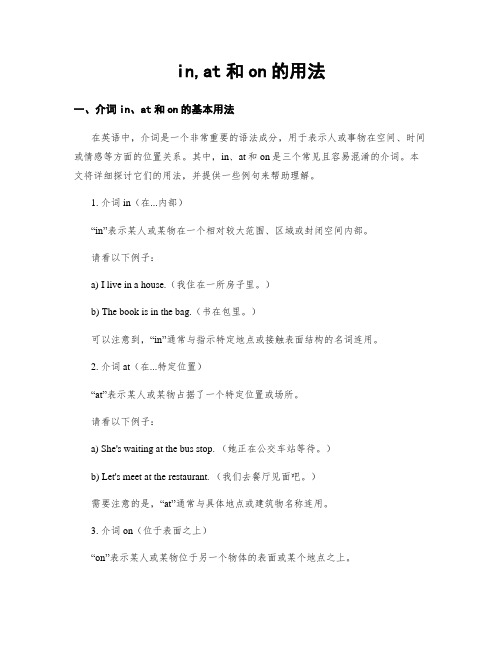
in,at和on的用法一、介词in、at和on的基本用法在英语中,介词是一个非常重要的语法成分,用于表示人或事物在空间、时间或情感等方面的位置关系。
其中,in、at和on是三个常见且容易混淆的介词。
本文将详细探讨它们的用法,并提供一些例句来帮助理解。
1. 介词in(在...内部)“in”表示某人或某物在一个相对较大范围、区域或封闭空间内部。
请看以下例子:a) I live in a house.(我住在一所房子里。
)b) The book is in the bag.(书在包里。
)可以注意到,“in”通常与指示特定地点或接触表面结构的名词连用。
2. 介词at(在...特定位置)“at”表示某人或某物占据了一个特定位置或场所。
请看以下例子:a) She's waiting at the bus stop. (她正在公交车站等待。
)b) Let's meet at the restaurant. (我们去餐厅见面吧。
)需要注意的是,“at”通常与具体地点或建筑物名称连用。
3. 介词on(位于表面之上)“on”表示某人或某物位于另一个物体的表面或某个地点之上。
请看以下例子:a) I put the cup on the table. (我把杯子放在桌子上。
)b) The cat is sitting on the chair. (猫坐在椅子上。
)可以注意到,“on”通常与接触表面或平面的物体连用。
二、in、at和on在时间表示中的用法除了表示空间位置外,in、at和on还可用于表示时间。
1. 介词in(在...期间)“in”用于表示某事发生或将要发生的某个时间段之内。
请看以下例子:a) I will see you in an hour.(一个小时后我会来见你。
)b) The concert is in December.(音乐会定于十二月举行。
)需要注意的是,“in”通常与较长的时间段连用,如小时、天、月份等。
介词at,in与on的用法与区别
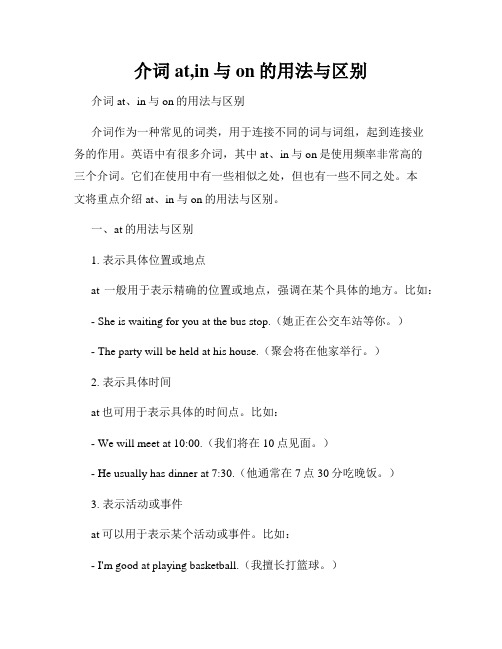
介词at,in与on的用法与区别介词at、in与on的用法与区别介词作为一种常见的词类,用于连接不同的词与词组,起到连接业务的作用。
英语中有很多介词,其中at、in与on是使用频率非常高的三个介词。
它们在使用中有一些相似之处,但也有一些不同之处。
本文将重点介绍at、in与on的用法与区别。
一、at的用法与区别1. 表示具体位置或地点at一般用于表示精确的位置或地点,强调在某个具体的地方。
比如:- She is waiting for you at the bus stop.(她正在公交车站等你。
)- The party will be held at his house.(聚会将在他家举行。
)2. 表示具体时间at也可用于表示具体的时间点。
比如:- We will meet at 10:00.(我们将在10点见面。
)- He usually has dinner at 7:30.(他通常在7点30分吃晚饭。
)3. 表示活动或事件at可以用于表示某个活动或事件。
比如:- I'm good at playing basketball.(我擅长打篮球。
)- She is laughing at the joke.(她正在笑这个笑话。
)二、in的用法与区别1. 表示位置或地点in通常用于表示一个相对较大的范围,比如国家、城市、街道等。
比如:- I live in China.(我住在中国。
)- The museum is in London.(博物馆在伦敦。
)2. 表示时间段in也可以表示一个具体的时间段。
比如:- He will arrive in an hour.(他将在一个小时后到达。
)- The project will be completed in two weeks.(这个项目将在两周内完成。
)3. 表示状态或条件in还可以用于表示某种状态或条件。
比如:- The flowers are in full bloom.(花开得很盛。
介词in,at,on的用法

介词in,at,on的用法一、介词in,at,on的基本用法介词是英语中非常重要且常用的词汇,在句子中起到连接作用,表示人或物在空间或时间上的位置关系。
其中,in、at和on是三个最常见的介词。
它们在使用时有着不同的规则和搭配方式。
1. in 的用法介词in表示“在……里面”、“在……之内”,常见于以下情境:a) 表示地点:例如,“in the room”(在房间里)、“in the garden”(在花园中)等。
b) 表示国家、城市和地区:例如,“in China” (在中国)、“in New York”(在纽约)等。
c) 表示特定位置:例如,“in front of the house”(在房子前面)、“in the corner”(在角落里)等。
d) 表示一段时间的具体部分:例如,“in the morning”(早上)、“in the evening”(傍晚)等。
2. at 的用法介词at表示“在……处”,常见于以下情境:a) 表示具体位置:例如,“at home”(在家)、“at school”(在学校)等。
b) 表示特定地点或建筑物:例如,“at the airport”(在机场)、“at the cinema” (在电影院)等。
c) 表示时间点:例如,“at 3 o'clock” (在3点钟)、“at noon”(在中午)等。
d) 表示某种状态或情感:例如,“good at swimming” (擅长游泳)、“angry at him”(对他生气)等。
3. on 的用法介词on表示“在……上方”,常见于以下情境:a) 表示具体位置:例如,“on the table”(在桌子上)、“on the bed”(在床上)等。
b) 表示交通工具:例如,“on the bus” (在公交车上)、“on the train”(乘坐火车)等。
c) 表示日期或特定的一天:例如,“on Monday”(星期一)、“on New Year's Day”(元旦)等。
【优质讲义】小学英语语法归纳训练讲义-12 介词in,on,at 全国通用版(含答案)

语法——介词in on atPart 1:学问点一、介词:是一种虚词,在句子中表示名词或代词与其他词之间的关系,不能单独做为句子成分,常位于名词或代词前面构成介词短语。
二、具体用法:常用介词1.in(1)表示方位:在……里面例句:There are three books in my bag.我书包里有三本书。
(2)表示地点:A.表示在大地方例句:I live in Hangzhou.我住在杭州。
B.表示属于该范围例句:Hei Longji ang lies in the north of China.黑龙江在中国北部。
(3)表示时间:A.表示一段时间(比较长)例:in summer在夏天in 2021在2021年in February 在二月B.表示在早上、下午、晚上例:in the morning/afternoon/evening(4)表示使用某种材料、语言等:例句:I can sing the song in English.我能用英语唱这首歌。
2.on(1)表示地点:在……上面例句:There is an apple on the desk.桌子上有一本书。
(2)表示时间:A.表示在具体某一天的上午、下午或晚上例:on June thirteenth在六月13日on the morning of May 1st在五月一日的早上B.表示在星期几的上午、下午或晚上例:on Friday在周五on Saturday afternoon在周六的下午2.at(1)表示在小地点:例:at school /home(2)表示时间点:例:at seven在七点at night在夜晚Part 2:练习一、用介词填空。
1.My mother begins to work ______ 8:00 ______ t he morning.2.Do you stay ______ home ______ weekend?3.They live ______ a new house now.4.Xinjiang is ______ the west of China.5.Lily usually have breakfast ______ the morning.6.They often have lunch ______ half past twelve.7.What’s this ______ English?8.There is a big gym ______ my school.9.She came to this city ______ 2020.10.It often snows here ______ winter.11.I will be back ______ a month.12.Don’t watch TV too much ______ the evening.13.Sally was born ______ May 11th.14.We don’t go to school ______ Saturday and S unday.15.They were happy ______ that time.16.______ the age of ten, I began to learn English.17.What do you often do ______ noon?18.______ a cold winter morning, I met her in the street.19.Mrs. Green came to Beijing ______ 2005.20.Children wake up very early ______ the morning ofChristmas Day.答案:1.at in2.at on3.in4.in5.in6.at7.in8.in9.in 10.i n 11.in 12.in 13.on 14.on 15.at 16.At 17.at 18.On 19.in 20.on。
in_on_at的用法口诀小学

in on at的用法口诀小学在英语学习中,常常会遇到三个小词in、on、at的用法。
这三个小词的使用很常见,但是却容易让学习者困惑。
为了帮助大家更好地掌握这三个介词的用法,下面给大家分享一个口诀,希望对大家有所帮助。
首先,我们来看看in的用法。
in表示“在……里面”、“在……之内”,常用来表示地点、国家、城市、建筑物等。
例如:in the room(在房间里)、in China(在中国)、in London(在伦敦)。
另外,in还可以表示在某个时间段内,例如:in the morning(在早上)、in July(在七月)。
接着,是on的用法。
on表示“在……上面”、“在……之上”,通常用来表示具体的日期、天、路线等。
比如:on the table(在桌子上)、on Monday(在星期一)、on the street(在街上)。
另外,on还可以用来表示具体的某一天,例如:on Christmas(在圣诞节那一天)。
最后是at的用法。
at表示“在……处”、“在……附近”,常用来表示具体的地点或事件。
例如:at the school(在学校)、at the party(在派对上)、at the airport(在机场)。
同时,at还可以表示具体的时间点,例如:at 3 o’clock(在三点钟)。
通过这样一个简单的口诀,我们可以更容易地记忆和区分in、on、at这三个介词的用法。
记住,在英语学习中,掌握好这些基础用法非常重要,希望大家能够通过不断的练习和积累,将这些知识牢牢记住,为自己的英语学习打下坚实的基础。
希望以上内容对大家有所帮助,祝大家学习进步,英语越来越好!1。
小学英语介词的用法总结

小学英语介词的用法总结介词的用法1.表示地点位置的介词1)at。
in。
on。
to,forat (1)表示在小地方。
(2)表示“在……附近,旁边”in (1)表示在大地方。
(2)表示“在…范围之内”。
on表示毗邻,接壤,“在……上面”。
to表示在……范围外,不强调是否接壤;或“到……”2)above。
over。
on在……上above指在……上方,不强调是否垂直,与below相对;over指垂直的上方,与under相对,但over与物体有一定的空间,不直接接触。
on表示某物体上面并与之接触。
The bird is flying above my head.There is a bridge over the river.He put his watch on the desk.3)below。
under在……上面under表示在…正下方below表示在……下,不一定在正下方There is a cat under the table.Please write your name below the line.4)in front [frant]of。
in the front of在……前面infrontof…意思是“在……前面”,指甲物在乙物之前,两者互不包括;其反义词是behind(在……的后面)。
There are some flowers in front of the house.(房子前面有些花卉。
)XXX意思是“在…。
的前部”,即甲物在乙物的内部.反义词是atthebackof…(在……范围内的后部)。
There is a blackboard in the front of our classroom.我们的教室前边有一块黑板。
XXX in the front of the classroom.我们的老师站在教室前.(老师在教室里)5)beside,XXXXXX表示在……旁边XXX表示在……后面2.表示时间的介词1)in。
小学英语语法——时间介词:in, on, at

时间介词:in, on, at什么是时间介词?时间介词是表示时间的介词。
时间介词辨析 in atonin表示一段时间1. 用于表月份、季节、年份的词前。
例:in May; in summer; in 20192. 与morning/afternoon/evening连用例:in the morning/afternoon/evening1. 用于星期、日期,或特定日期的早上、下午、晚上前;2. 与day搭配,表示具体某一天。
例:We have six classess on Monday.New Year's Day is on January 1st.Mary was born on a cold day.on表示具体的某一天1. 表示具体的时刻,意为“在某一时刻”,常与o'clock,half past等表示具体时间的短语连用。
例:I always get up at 7:00 o'clock.We'll have lunch at half pasttwelve.2. 表示人的年龄,用于固定搭配“at the age of...”,意为“在……岁时”。
常用于一般过去时中。
例:I started to learn English at theage of four.3. 表示一段时间,意为“在……期间”。
例:It was ver cold at night.Sally and her family had a good time atChrismas.(这里不是只指在圣诞节当天)Practice1. There are many flowers _____________spring.2. I'm going to buy a gift ______________ the afternoon of May 30th.3. Lily went to the park ______________ four yesterday afternoon.in onatSee you next time!。
六年级下册英语语法介词atin与on的用法与区别全国通用
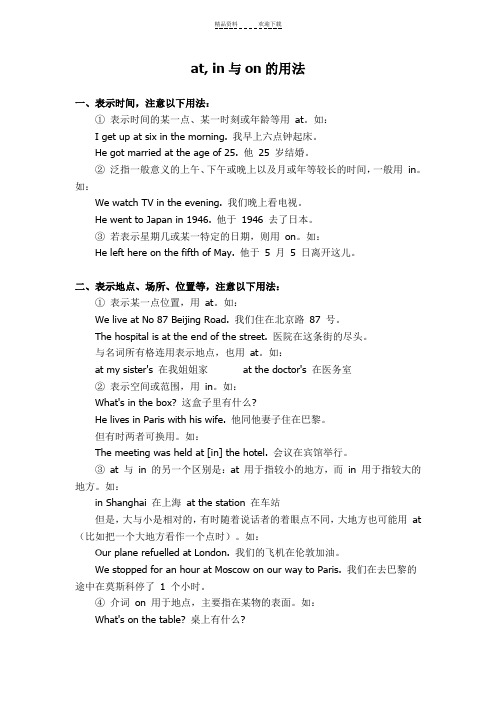
at, in与on的用法一、表示时间,注意以下用法:①表示时间的某一点、某一时刻或年龄等用at。
如:I get up at six in the morning. 我早上六点钟起床。
He got married at the age of 25. 他25 岁结婚。
②泛指一般意义的上午、下午或晚上以及月或年等较长的时间,一般用in。
如:We watch TV in the evening. 我们晚上看电视。
He went to Japan in 1946. 他于1946 去了日本。
③若表示星期几或某一特定的日期,则用on。
如:He left here on the fifth of May. 他于5 月5 日离开这儿。
二、表示地点、场所、位置等,注意以下用法:①表示某一点位置,用at。
如:We live at No 87 Beijing Road. 我们住在北京路87 号。
The hospital is at the end of the street. 医院在这条街的尽头。
与名词所有格连用表示地点,也用at。
如:at my sister's 在我姐姐家at the doctor's 在医务室②表示空间或范围,用in。
如:What's in the box? 这盒子里有什么?He lives in Paris with his wife. 他同他妻子住在巴黎。
但有时两者可换用。
如:The meeting was held at [in] the hotel. 会议在宾馆举行。
③at 与in 的另一个区别是:at 用于指较小的地方,而in 用于指较大的地方。
如:in Shanghai 在上海at the station 在车站但是,大与小是相对的,有时随着说话者的着眼点不同,大地方也可能用at (比如把一个大地方看作一个点时)。
如:Our plane refuelled at London. 我们的飞机在伦敦加油。
- 1、下载文档前请自行甄别文档内容的完整性,平台不提供额外的编辑、内容补充、找答案等附加服务。
- 2、"仅部分预览"的文档,不可在线预览部分如存在完整性等问题,可反馈申请退款(可完整预览的文档不适用该条件!)。
- 3、如文档侵犯您的权益,请联系客服反馈,我们会尽快为您处理(人工客服工作时间:9:00-18:30)。
早、午、晚要用in,at黎明、午夜、点与分。
年、月、年月、季节、周,阳光、灯、影、衣、帽in。
将来时态in...以后,小处at大处in。
有形with无形by,语言、单位、材料in。
特征、方面与方式,心情成语惯用in。
介词at和to表方向,攻击、位置、恶、善分。
日子、日期、年月日,星期加上早、午、晚,收音、农场、值日on,关于、基础、靠、著论。
着、罢、出售、偷、公、假,故意、支付、相反,准。
特定时日和"一……就",on后常接动名词。
年、月、日加早、午、晚,of之前on代in。
步行、驴、马、玩笑on,cab,carriage则用in。
at山脚、门口、在当前,速、温、日落、价、核心。
工具、和、同随with,具有、独立、就、原因。
就……来说宾译主,对、有、方状、表细分。
海、陆、空、车、偶、被by,单数、人类know to man。
this、that、tomorrow,yesterday,next、last、one。
接年、月、季、星期、周,介词省略已习惯。
over、under正上下,above、below则不然,若与数量词连用,混合使用亦无关。
'beyond超出、无、不能,against靠着,对与反。
besides,except分内外,among之内along沿。
同类比较except,加for异类记心间。
原状because of,、owing to、due to表语形容词under后接修、建中,of、from物、化分。
before、after表一点, ago、later表一段。
before能接完成时,ago过去极有限。
since以来during间,since时态多变换。
与之相比beside,除了last but one。
复不定for、找、价、原,对、给、段、去、为、作、赞。
快到、对、向towards,工、学、军、城、北、上、南。
but for否定用虚拟,复合介词待后言。
ing型由于鉴,除了除外与包合。
之后、关于、在......方面,有关介词须记全。
in内to外表位置,山、水、国界to在前。
2.介词填空①Tony is ________ Canada.②What is the name ________ the factory?③Betty is English. What ________ you?④Who’s the woman ________ the black dress?⑤Where do you come ________?⑥She looks ________ her father.⑦Do the students stay ________ home ________ Saturday?⑧My mother cut the cake ________ a knife .⑨The meeting ended ________ 6 p.m.⑩We’ll play football ________ class.○11Go ________ this road, turn left ________ the first crossing.○12Can you tell me the way ________ the zoo?○13—where are you from?—I am ________ Beijing.○14Let’s count the numbers ________ one ________ fifty.○15—Where shall we meet?—We’ll meet ________ home.1,We went to the country_________ a very cold morning.A. atB. inC. onD. of2,China lies_______ the east of Asia and_______ the north of Australia.A. to; toB. in; toC. to; inD. in; on3, I didn't go to the park with my classmates, because my mother asked me to_______ my little sister at home.A. look afterB. look atC. look forD. look like4, If you are able to get the tickets tomorrow, please tell me_____ phone.A. atB. byC. onD. through5, Lyon wanted to be a soldier and his dream came true_______ November 25th,2008.A. inB. duringC. onD. at6,My father usually comes back from work_______ 6:30_______ the evening.A. in; onB. in; atC. on; inD. at; in7, This kind of machine was widely used_________ the 1960s.A. inB. forC. atD. on8,I've never seen such a scary film________ my lifeA. byB. atC. onD. in( ) 1. Children get gifts ____ Christmas and ____ their birthdays.A. on; onB. at; onC. in; inD. in; on( ) 2.----There is nothing ____tomorrow afternoon, is there? -----No. We can have a game of table tennis.A. onB. inC. outD. up( ) 3. A lot of students in our school were born____March, 1981.A. inB. atC. onD. since( ) 4. He suddenly returned____ a rainy night.A. onB. atC. inD. during( ) 5. My grandfather was born____Oct. 10, 1935.A. onB. inC. atD. of( ) 6. The train is starting___five minutes.A. inB. atC. forD.still( ) 7. Mike does his exercises ____ seven _____ the evening.A. on; toB. at; inC. by; ofD. at; on( ) 8. Children wake up very early____the morning of Christmas Day.A. inB. onC. forD. at( ) 9 ____ a cold winter morning, I met her in the stfeet.A. InB. OnC. AtD. For( ) 10 It happened to be very cold____ the morning of our sports meeting.A. atB. onC. withD. of( ) 11. Why did you get up so early ___ this morning.A. onB. /C. atD. in( ) 12. He went to Shanghai___ September 3, 1991 and came back___ a cold morning last year.A. in; onB. on; inC. on; onD. in; ia( ) 13. Lucy was born____ the night of May 12, 1984. . ...A. onB. inC. atD. to( ) 14. Mrs Brown came to China ____ 1996.A.onB. ofC. to,D. in( ) 15 ___ the morning of November 20, 1915, the workers came to Chicago to show their mourning of Joe Hill.A. OnB. InC. OnD. At( ) 16. Ann moved___Hangzhou___September, 1992.A. /; inB. to; inC. to; on D, in; in( ) 17. They started off___an autumn afternoon.A. duringB. atC. inD. on( ) 18. He often goes ____ school ____ six thirty ____ the morning.A. for; to; inB. to; at; inC. to; for; at D, for; at; to( ) 19. He arrived ___ Shanghai ___ 9: 30 ___ March 5. A. at; in; at B. to; on; at C. in; on; at D. in; at; on( ) 20.The English teacher told me to get there____ half past ten.A: in B. at C. on D. of答案:B A A A A A B B B B B C A D B A D B D B。
